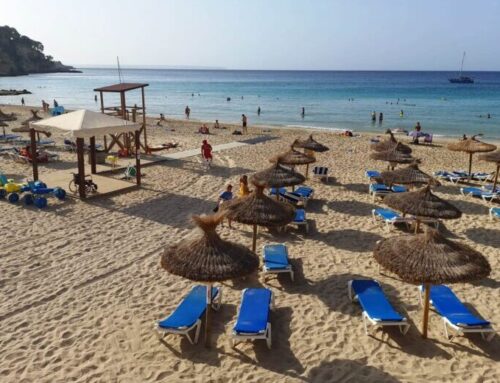The Balearic economy has started with strength after registering an intense growth of 3.2 percent during the first quarter of this year 2024, according to the Economic Analysis of the Balearic Islands presented by the Vice President of the Government, Antoni Costa, and the Director General of Economy and Statistics, Catalina Barceló.

Catalina Barceló and Antoni Costa, during the presentation of the Economic Analysis of the Balearic Islands. Photo: CAIB.
The notable increase in value and quantity of the services sector, the recovery of construction, and the dynamism of the labor market across all sectors, which surpasses previous records, have been the main drivers of this economic growth that doubles that of 2019 and exceeds the national average of 2.4%. By islands, the Pitiusas lead the growth with 4.8%, followed by Mallorca with 3.1%, and Menorca with 2.7%.
The services sector, engine of the Balearic economy’s growth
The services sector, with its notable dynamism, continues to drive economic growth, recording an increase of 3.6% thanks to a significant intensification of sales (8% compared to 0.5% nationally). Agriculture and fishery also show improvements (3.2%), as well as construction (1.7%). However, industry and energy are the only sectors experiencing a decline, with a decrease of 3.7%, mainly due to low activity in March. Nevertheless, April figures indicate a recovery, suggesting that this decline is temporary.
Regarding inflation, over the last three months, the downward trend has been broken, with an annual variation of 3.8%, similar to the national rate of 3.6%. Increases in prices are primarily concentrated in food, restaurants, and housing.
Tourism on the rise
The report confirms the growth of tourism in value and volume. Tourist spending reaches a new record, with an increase of 8.1% in spending per person per day (161 euros), an annual variation of 13.3%, and an average spending per person of 1,023 euros, totaling 2,797.9 million euros. This represents a 40% increase between 2016 and 2024.
The volume of tourists is also growing, with 2.7 million arrivals through April, a 7.4% increase, with 72.3% being international visitors. Tourist arrivals during the low season months have significantly increased, reflecting greater seasonality diversification. Hotel overnight stays rise by 18.5%, reaching 5.9 million in the first four months, with an average stay of 4.4 days. Additionally, passenger traffic at airports grows by 5.3%, reaching 4.2 million travelers in the first four months.
Areas for improvement
Costa has identified several key areas for improving productivity and citizen well-being:
- Improvement of GDP per capita: Restoring competitiveness and enhancing sectorial productivity.
- Sectorial analysis: Focusing on efficient policy strategies based on each sector’s behavior.
- Increasing education and specialization.
- Administrative simplification: Reducing bureaucracy.
- Promotion of labor flexibility: Work-life balance and shared responsibility.
- Innovation and technological investment: Modernizing businesses and public administrations.
- Diversification of sectoral activities.
- Investment in natural capital and infrastructure.
These efforts aim to improve both labor productivity, which has decreased by 21% over 27 years, and capital productivity, which has fallen by 42.6% since 1995.







Leave A Comment